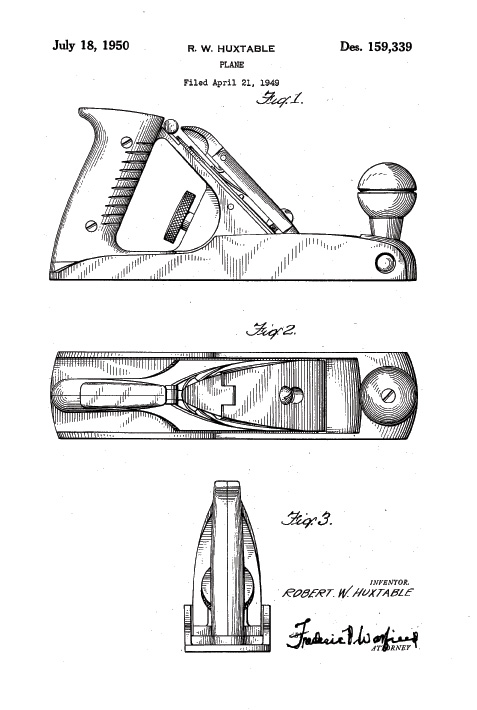Stanley Block Planes Demystified
January 27, 2014 18 Comments
 Stanley was surely not lacking in its appetite for block planes, offering models and variations of models in every size and flavor imaginable. Trying to figure out all the models and differences is maddening. Since search phrases most frequently entered by those visiting Virginia Toolworks include which block plane to buy, I thought it might be helpful to provide a list of Stanley’s block plane models organized by functional group and mechanical similarity (rather than numerical model order). For detailed specifications on each model, please check my Block Plane Chart and the Block Plane Dating page.
Stanley was surely not lacking in its appetite for block planes, offering models and variations of models in every size and flavor imaginable. Trying to figure out all the models and differences is maddening. Since search phrases most frequently entered by those visiting Virginia Toolworks include which block plane to buy, I thought it might be helpful to provide a list of Stanley’s block plane models organized by functional group and mechanical similarity (rather than numerical model order). For detailed specifications on each model, please check my Block Plane Chart and the Block Plane Dating page.
Note that the functional groups are not necessarily mutually exclusive. The same plane will be found in more than one functional group as I’ve categorized them. Therefore, you will see a lot of duplication. I listed them this way on purpose. It’s also worth noting that competitors like Millers Falls, Sargent, and others offered comparable models to many of these.
Block Planes Sorted by Functional Group & Mechanical Similarity
Basic Handyman Planes

Early Stanley no. 120 c. 1870s-80s
- No. 9-1/4 – 6 inches long and standard angle, this plane was identical to the no. 9-1/2 in every way except it doesn’t have an adjustable mouth. It was a cheaper alternative and never as desirable as the 9-1/2. Features a thumb rest instead of a front knob.
- No. 100 – 3-1/2 inches long and standard angle, this tiny plane is a simple palm sized plane with a raised “squirrel tail” handle and thumb screw tightened lever cap. Features a thumb rest instead of a front knob.
- No. 101 – 3-1/2 inches long and standard angle, this plane is identical to the no. 100, except it does not have the squirrel tail. Originally sold in toy tool chests before becoming available within Stanley’s line. Features a thumb rest instead of a front knob.
- No. 102 – 5-1/2 inches long and standard angle, this plane was another very basic small size block plane. This one featured a tension adjustment wheel for the lever cap and a thumb rest instead of a front knob.
- No. 103 – 5-1/2 inches long and standard angle, this plane is similar to the no. 102 but adds a poorly designed lever adjustment feature and a wooden front knob.
- No. 110 – 7 inches long and standard angle, featuring a wooden front knob, this plane is otherwise the same as the no. 102, however it was far more popular.
- No. 120 – 7 inches long and standard angle, this plane is similar to the smaller no. 103 with the same inadequate adjustment mechanism and wooden front knob.
- No. 203 – 5-1/2 inches long and standard angle, this plane featured the same hooded lever cap found on the 9-1/2 series, a screw type depth adjustment similar to the low angle blocks, and a wooden front knob.
- No. 220 – 7 inches long and standard angle, this plane is otherwise identical to the no. 203 but was far more popular.
Fixed Mouth Planes
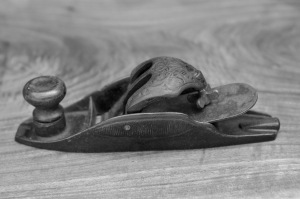
Stanley No. 110 Type 1 c. 1874
- No. 9-1/4 – 6 inches long and standard angle, this plane was identical to the no. 9-1/2 in every way except it doesn’t have an adjustable mouth. It was a cheaper alternative and never as desirable as the 9-1/2. Features a thumb rest instead of a front knob.
- No. 18-1/4 – 6 inches long and standard angle, this plane was identical to the no. 18 except it didn’t have an adjustable throat. It was only made from 1952-58 and is somewhat rare.
- No. 61 – 6 inches long and low angle, this plane was identical to the no. 60 but had no adjustable throat and featured a wooden front knob. These are relatively rare.
- No. 63 – 7 inches long and low angle, this plane was identical to the no. 65-1/2 (hooded lever cap) but had no adjustable throat and featured a wooden front knob. These are also relatively rare.
- No. 100 – 3-1/2 inches long and standard angle, this tiny plane is a simple palm sized plane with a raised “squirrel tail” handle and thumb screw tightened lever cap. Features a thumb rest instead of a front knob.
- No. 100-1/2 – 3-1/2 inches and standard angle, this plane is identical to the 100, but has a convex sole and iron for shaving concave surfaces such as chair seats. This one is pretty handy for those tasks and there are modern versions being sold today.
- No. 101 – 3-1/2 inches long and standard angle, this plane is identical to the no. 100, except it does not have the squirrel tail. Originally sold in toy tool chests before becoming available within Stanley’s line. Features a thumb rest instead of a front knob.
- No. 101-1/2 – 3-1/2 inches and standard angle, this is a bull-nose version of the no. 101. It is extremely rare with fine examples selling in the $500 range.
- No. 102 – 5-1/2 inches long and standard angle, this plane was another very basic small size block plane. This one featured a tension adjustment wheel for the lever cap and a thumb rest instead of a front knob.
- No. 103 – 5-1/2 inches long and standard angle, this plane is similar to the no. 102 but adds a poorly designed lever adjustment feature and a wooden front knob.110 – 7 inches long and featuring a wooden front knob, this plane is otherwise the same as the no. 102, however it was far more popular.
- No. 110 – 7 inches long and standard angle, featuring a wooden front knob, this plane is otherwise the same as the no. 102, however it was far more popular.
- No. 120 – 7 inches long and standard angle, this plane is similar to the smaller no. 103 with the same inadequate adjustment mechanism and wooden front knob.
- No. 130 – 8 inches long and standard angle, this double ended plane featured a tension wheel lever cap. Bull-nose on one end and standard nose on the other, the iron could be reversed for dual purpose use.
- No. 131 – 8 inches and standard angle, this plane was similar to the no. 130 but featured a hooded lever cap and a screw type depth adjustment. It is considered superior to the no. 130, but the mechanism is fragile.
- No. 140 – 7 inches long and standard angle, this rabbet plane’s iron was set at a skew angle, and its side was removable for precise rabbeting. This plane is very useful with modern variations still being made.
- No. 203 – 5-1/2 inches long and standard angle, this plane featured the same hooded lever cap found on the 9-1/2 series, a screw type depth adjustment similar to the low angle blocks, and a wooden front knob.
- No. 220 – 7 inches long and standard angle, this plane is otherwise identical to the no. 203 but was far more popular.
Adjustable Mouth Planes
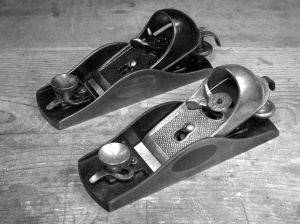
Stanley no. 9-1/2 and no. 16 c. 1904-08
- No. 9-1/2 – 6 inches long and standard angle, this was Stanley’s most successful block plane. Featuring a hooded lever cap, lateral adjustment lever, iron depth adjustment, and an adjustable throat, this plane set the standard for the industry.
- No. 9-3/4 – 6 inches long and standard angle, this plane was identical to the no. 9-1/2 with the addition of an arm with a wooden knob attached to the rear. There were far fewer of these planes made and they can easily sell for several hundred dollars today.
- No. 15 – 7 inches long, this plane was otherwise identical to the no. 9-1/2.
- No. 15-1/2 – 7 inches long, this plane is otherwise identical to the no. 9-3/4 with the same wooden knob at the rear.
- No. 16 – 6 inches long and standard angle, this plane was identical to the no. 9-1/2 except it had a nickel plated lever cap whereas the no. 9-1/2’s cap was japanned.
- No. 17 – 7 inches long and standard angle, this plane is otherwise identical to the no. 15 except it had a nickel plated lever cap whereas the no. 15’s cap was japanned.
- No. 18 – 6 inches long and standard angle, this plane was identical to the no. 9-1/2 except the lever cap (after 1913) was the knuckle style cap (also found on the no. 65). Although not quite as popular as the no. 9-1/2, this is my preferred standard angle block plane for its comfort in use.
- No. 19 – 7 inches long and standard angle, this plane is otherwise identical to the no. 18.
- No. 60 – 6 inches long and narrower than most of the other planes this length (1-3/8″), this low angle block featured a hooded style lever cap, screw depth adjustment, and adjustable throat. It’s lever cap and hardware were nickel plated.
- No. 60-1/2 – 6 inches long and low angle, this plane is identical to the no. 60 in every way except its lever cap was japanned. The no. 60 and no. 60-1/2 are frequently confused as there has been conflicting information published online. Just remember, the 60-1/2 has a japanned cap.
- No. 65 – 7 inches and low angle, this plane is often referred to as the “Cadillac” of block planes. It features the same nickel plated knuckle cap as the 18/19 planes, and the same screw type depth adjustment of the 60 series low angle blocks. And of course the throat is adjustable.
- No. 65-1/2 – 7 inches long and low angle, this 65-1/2 is identical to the no. 65 except it had a japanned hooded style lever cap throughout it’s entire life. This confuses a lot of people since the no., 65 switched from a hooded cap to a knuckle cap in about 1913.
Standard Angle Planes
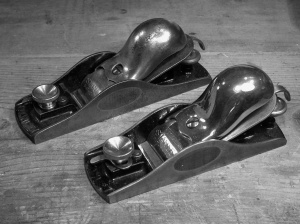
Stanley no. 19 & no. 18 c. 1913-18
- No. 9-1/4 – 6 inches long and standard angle, this plane was identical to the no. 9-1/2 in every way except it doesn’t have an adjustable mouth. It was a cheaper alternative and never as desirable as the 9-1/2. Features a thumb rest instead of a front knob.
- No. 9-1/2 – 6 inches long and standard angle, this was Stanley’s most successful block plane. Featuring a hooded lever cap, lateral adjustment lever, iron depth adjustment, and an adjustable throat, this plane set the standard for the industry.
- No. 9-3/4 – 6 inches long and standard angle, this plane was identical to the no. 9-1/2 with the addition of an arm with a wooden knob attached to the rear. There were far fewer of these planes made and they can easily sell for several hundred dollars today.
- No. 15 – 7 inches long, this plane was otherwise identical to the no. 9-1/2.
- No. 15-1/2 – 7 inches long, this plane is otherwise identical to the no. 9-3/4 with the same wooden knob at the rear.
- No. 16 – 6 inches long and standard angle, this plane was identical to the no. 9-1/2 except it had a nickel plated lever cap whereas the no. 9-1/2’s cap was japanned.
- No. 17 – 7 inches long and standard angle, this plane is otherwise identical to the no. 15 except it had a nickel plated lever cap whereas the no. 15’s cap was japanned.
- No. 18 – 6 inches long and standard angle, this plane was identical to the no. 9-1/2 except the lever cap (after 1913) was the knuckle style cap (also found on the no. 65). Although not quite as popular as the no. 9-1/2, this is my preferred standard angle block plane for its comfort in use.
- No. 19 – 7 inches long and standard angle, this plane is otherwise identical to the no. 18.
- No. 100 – 3-1/2 inches long and standard angle, this tiny plane is a simple palm sized plane with a raised “squirrel tail” handle and thumb screw tightened lever cap. Features a thumb rest instead of a front knob.
- No. 100-1/2 – 3-1/2 inches and standard angle, this plane is identical to the 100, but has a convex sole and iron for shaving concave surfaces such as chair seats. This one is pretty handy for those tasks and there are modern versions being sold today.
- No. 101 – 3-1/2 inches long and standard angle, this plane is identical to the no. 100, except it does not have the squirrel tail. Originally sold in toy tool chests before becoming available within Stanley’s line. Features a thumb rest instead of a front knob.
- No. 101-1/2 – 3-1/2 inches and standard angle, this is a bull-nose version of the no. 101. It is extremely rare with fine examples selling in the $500 range.
- No. 102 – 5-1/2 inches long and standard angle, this plane was another very basic small size block plane. This one featured a tension adjustment wheel for the lever cap and a thumb rest instead of a front knob.
- No. 103 – 5-1/2 inches long and standard angle, this plane is similar to the no. 102 but adds a poorly designed lever adjustment feature and a wooden front knob.
- No. 110 – 7 inches long and standard angle, featuring a wooden front knob, this plane is otherwise the same as the no. 102, however it was far more popular.
- No. 120 – 7 inches long and standard angle, this plane is similar to the smaller no. 103 with the same inadequate adjustment mechanism and wooden front knob.
- No. 130 – 8 inches long and standard angle, this double ended plane featured a tension wheel lever cap. Bull-nose on one end and standard nose on the other, the iron could be reversed for dual purpose use.
- No. 131 – 8 inches and standard angle, this plane was similar to the no. 130 but featured a hooded lever cap and a screw type depth adjustment. It is considered superior to the no. 130, but the mechanism is fragile.
- No. 140 – 7 inches lo
ng and standard angle, this rabbet plane’s iron was set at a skew angle, and its side was removable for precise rabbeting. This plane is very useful with modern variations still being made. - No. 203 – 5-1/2 inches long and standard angle, this plane featured the same hooded lever cap found on the 9-1/2 series, a screw type depth adjustment similar to the low angle blocks, and a wooden front knob.
- No. 220 – 7 inches long and standard angle, this plane is otherwise identical to the no. 203 but was far more popular.
Low Angle Planes
- No. 61 – 6 inches long and low angle, this plane was identical to the no. 60 but had no adjustable throat and featured a wooden front knob. These are relatively rare.
- No. 63 – 7 inches long and low angle, this plane was identical to the no. 65-1/2 (hooded lever cap) but had no adjustable throat and featured a wooden front knob. These are also relatively rare.
- No. 60 – 6 inches long and narrower than most of the other planes this length (1-3/8″), this low angle block featured a hooded style lever cap, screw depth adjustment, and adjustable throat. It’s lever cap and hardware were nickel plated.
- No. 60-1/2 – 6 inches long and low angle, this plane is identical to the no. 60 in every way except its lever cap was japanned. The no. 60 and no. 60-1/2 are frequently confused as there has been conflicting information published online. Just remember, the 60-1/2 has a japanned cap.
- No. 65 – 7 inches and low angle, this plane is often referred to as the “Cadillac” of block planes. It features the same nickel plated knuckle cap as the 18/19 planes, and the same screw type depth adjustment of the 60 series low angle blocks. And of course the throat is adjustable.
- No. 65-1/2 – 7 inches long and low angle, this 65-1/2 is identical to the no. 65 except it had a japanned hooded style lever cap throughout it’s entire life. This confuses a lot of people since the no., 65 switched from a hooded cap to a knuckle cap in about 1913.
Bull-nose Planes

Stanley no. 131 Plane c. 1920s
- No. 101-1/2 -3-1/2 inches and standard angle, this plane is identical to the 100, but has a convex sole and iron for shaving concave surfaces such as chair seats. This one is pretty handy for those tasks and there are modern versions being sold today.
- No. 130 – 8 inches long and standard angle, this double ended plane featured a tension wheel lever cap. Bull-nose on one end and standard nose on the other, the iron could be reversed for dual purpose use.
- No. 131 – 8 inches and standard angle, this plane was similar to the no. 130 but featured a hooded lever cap and a screw type depth adjustment. It is considered superior to the no. 130, but the mechanism is fragile.
Instrument Makers Planes

Stanley no. 101-1/2 Plane c. 1890s
- No. 100 – 3-1/2 inches long and standard angle, this tiny plane is a simple palm sized plane with a raised “squirrel tail” handle and thumb screw tightened lever cap. Features a thumb rest instead of a front knob.
- No. 100-1/2 – 3-1/2 inches and standard angle, this plane is identical to the 100, but has a convex sole and iron for shaving concave surfaces such as chair seats. This one is pretty handy for those tasks and there are modern versions being sold today.
- No. 101 – 3-1/2 inches long and standard angle, this plane is identical to the no. 100, except it does not have the squirrel tail. Originally sold in toy tool chests before becoming available within Stanley’s line. Features a thumb rest instead of a front knob.
- No. 101-1/2 – 3-1/2 inches and standard angle, this is a bull-nose version of the no. 101. It is extremely rare with fine examples selling in the $500 range.
Rabbet (Rebate) Planes
- No. 140 – 7 inches long and standard angle, this rabbet plane’s iron was set at a skew angle, and its side was removable for precise rabbeting. This plane is very useful with modern variations still being made.
***
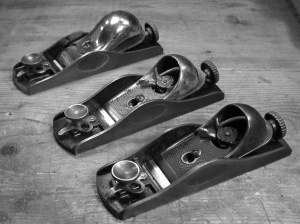
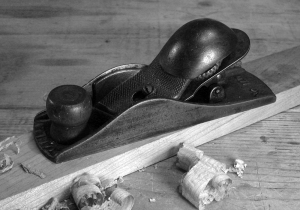







 Every metal worker needs a polishing machine, and mine is typical of those found in smaller shops. It is a floor standing model with hoods and a powerful dust collection unit. This not only keeps the work space cleaner, but captures most of the particulates, which are comprised of a surprisingly high percentage of fine metal material. This too is sent for refining and metal reclamation.
Every metal worker needs a polishing machine, and mine is typical of those found in smaller shops. It is a floor standing model with hoods and a powerful dust collection unit. This not only keeps the work space cleaner, but captures most of the particulates, which are comprised of a surprisingly high percentage of fine metal material. This too is sent for refining and metal reclamation.








